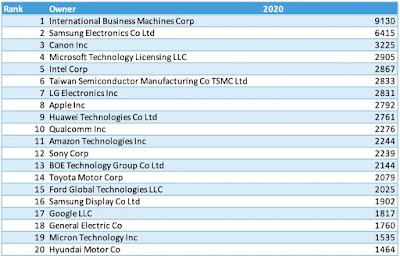IBM is again the leader in patents issued. That’s 28 years and running. IBM had 9,130 patents issued in 2020, compared to the next highest, Samsung with 6,416. There’s about 15 electronic and manufacturing companies with 2,000 to 3,000 patents issued. Note that all the top 10 are electronics and/or chip makers. Forbes has a nice article by Roberts about the top 20 patent recipients of 2020.
A couple years ago, Samsung kinda dethroned the King as discussed in our 2017 blog post: The End of a Patent Dynasty, IBM has Been Dethroned. Samsung, including all of its related companies, with lots and lots of design patents, outpaced IBM in 2016. For 2020, Samsung Display company had 1,902 patents, so Samsung, as a consortium of companies, again rivals IBM in total patents.
GE, even though it is a shell of it’s former mega company, is still in the top 18, with 1,760 patents. GE continues to divest of various business unites including financials to focus on a few core business like turbines, renewables, transportation and healthcare.
A Bloomberg article by Brody Ford on March 12 2021 discusses IBM as more of a Godfather of Patents than a King. With more that 38,000 active patents and a spectacular war chest of patent licenses, or cross licenses, IBM is a force to be reckoned with. Ford discussed Chewy fighting back, kind of the dog nipping at the heels of the King (or the Godfather). IBM is way down from the times when it was customary to produce $1B a year from licensing royalties. Patent revenues peaked at $1.7B in 2000 and then again in 2016 at $1.6B. The patent landscape has changed. One thing that Ford alluded to, but didn’t fully address, is that IBM has significantly changed the way they approach patent commercialization. If they can’t directly use patents, they seem to be doing a much better job of figuring out ways to commercialize. If they sell the patent, that, I believe, would not show up in their patent revenues which reflects royalty streams.
In the meanwhile, IBM is on a multi-decade move to upgrade the company to more relevant businesses and business models. Mainframes are only needed for businesses in “as a service” models (SaaS).
IBM is a leader in Quantum computing and in blockchain. IBM is actually my way to play the blockchain mega trend and avoid the mania associated with various bits and bytes of cyber coins.

